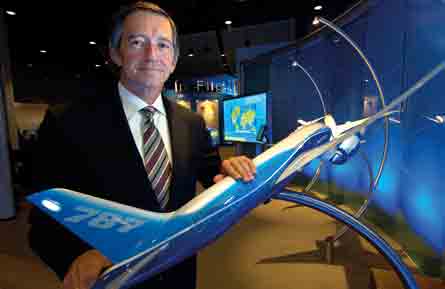Fast introduction of the fleet is prompting Boeing to set up pioneering training and support initiatives for the 787
Boeing and Alteon, the company’s full-service airline training provider, are in the midst of developing a comprehensive and, in some ways, pioneering new approach to both flight crew and maintenance training for the 787.
Boeing 787 training director Alfred Nader says: “We’re taking advantage of new training and teaching methodologies to come up with a revolutionary training system for a revolutionary new aircraft.” The system will include more advanced computer-based trainers (CBT) – which are linked to full-flight simulators – and touch-screen, flat panel trainers that will replace traditional CBTs. “Desktop simulators will also replace traditional maintenance-based trainers,” says Nader.
|
|---|
Bob Avery, vice president 787 support and services at Boeing and head of the GoldCare programme with a model 787 |
Boeing vice-president of 787 services and support Bob Avery says: “Rockwell Collins supplies more than a quarter of the systems by value aboard the 787, so its leadership in joining GoldCare is a terrific boost.”
To help pave the way, as well as meet the surge in demand and the relatively fast introduction of the fleet, Alteon is quickly establishing an international training network. “It has nine full suites of 787 training systems on order,” says Nader, who says each will cover “flight training, maintenance and door training. Six will be available before entry into service in mid-2008.” The initial training centre will be sited in Seattle with others following in Australia, China, India, Japan, Singapore and the UK.
As part of the new concept, Boeing and Alteon are in talks with the US Federal Aviation Administration and other regulatory authorities to allow pilots to transition to the 787 from the 777 without going through a full-flight simulator. Using a combination of CBT, scenario-based training (SBT) and flat panel simulators instead of the current fixed-base and full-flight simulator, Boeing believes the 777 to 787 transition could be accomplished in five days. “It is a challenge, but we think it’s [feasible],” says Nader. “We’ve talked with the authorities and it could be achievable.”
The flightdeck is designed for “mixed-fleet flying” and to make conversions relatively straightforward for crews coming from other Boeing types, particularly those with glass cockpit experience from the 757/767. Crews coming to or from the Next Generation 737 and 757/767 will require eight days of “differences” training, while 10 days will be needed for crews transitioning from the 747-400 to the 787. The current transition time from non-Boeing types is 21 days and “we are looking at shortening that time from Airbus types to the 787 and any Boeing aircraft”, he adds.
To aid the planning and approval process for all the 787 training curricula with regulatory authorities, Boeing and Alteon have developed a pilot qualification plan (PQP) and a separate mechanic qualification plan (MQP). The PQP was first used for the 737 Next Generation, while the MQP “is a first for us”, according to Nader.
Gold-level service
Maintenance training will introduce “a whole new paradigm in the way we train. The beauty here is that they’ll be using the same tools in the classroom as they will be on the job.” Working closely with MyBoeingFleet – Boeing’s secure web portal that supports owners, operators, maintenance, repair and overhaul (MRO) operators – a curriculum is being developed that will use three-dimensional graphics, computer- and simulation-based training. “We have a great concept and there are still things to be worked out, but there are no red flags at this point,” says Nader.
Boeing is continuing to grow its innovative GoldCare “life-cycle” management service developed to help 787 customers by signing up a raft of major equipment and maintenance suppliers. Rockwell Collins joined the fold on 14 September, entering the programme hot on the heels of Hamilton Sundstrand, SR Technics and Smiths Aerospace, with a further 20 or so additional partners still due to join. GoldCare is an all-encompassing maintenance and materials management service. By offering customers at airframe level a single contact point, Boeing says GoldCare will give them a predictable cost base and reliability guarantees, while Boeing will manage all activities and transactions.
|
|---|
Boeing's GoldCare operations centre will monitor and manage performance information |
By year-end, Boeing also hopes to announce up to two more GoldCare maintenance partners to add to SR Technics, and possibly another three major equipment suppliers in the same timeframe.
Two GoldCare packages are offered, the first of which is a life-cycle management option offering fleet maintenance management and parts support. The second is an integrated materials management plan that includes spare parts as well as repair and overhaul options. Customers can sign variable length contracts, but will sign up 12-18 months ahead of their first aircraft entering service.
Boeing says the scheme is expected to benefit 787 operators at every stage from acquisition to disposal. GoldCare, it says, will help the airlines access favourable financing, minimise infrastructure requirements, eliminate inventory costs and oil the wheels for rapid type introduction. While in service, it says GoldCare will help with schedule reliability, make costs predictable and transfer risk to Boeing and its partners. The company also believes the scheme will help retain residual value.
Hamilton Sundstrand customer service vice-president Mike Dumais says: “We have a lot of activity and we are working closely with Boeing on a lot of elements to get ready for entry into service.” It is currently preparing a preliminary draft of “T-files” that list the parts covered by the scheme, which Dumais says is vital “...when you have 500 or so parts and thousands and thousands of piece parts. We are working closely with Boeing to develop ‘meet and greet’ schemes for the aircraft, as well as adding dedicated field service representatives to support the aircraft.”
Source: Flight International

























